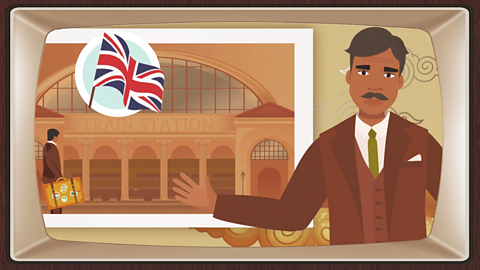Key points
- Thousands of men and women from the Caribbean fought for Britain in World War Two. Most returned to the Caribbean when the war ended.
- Between 1948 and 1971, it is estimated that 500,000 people migrated to Britain from the Caribbean as part of the Windrush generation.
- The Windrush generation has made a significant cultural impact on British society today, through food, language and music.
Video about post-war migration to the UK
Narrator: People from all over the world have migrated to and from the UK for centuries. After World War Two, people had more opportunities to travel to the UK from the Caribbean, Asia and Africa. Everyone has their own story about why they moved and the challenges they faced.
Jamaican woman: I worked in a hospital in Kingston, Jamaica. The Jamaican economy was not doing well and jobs were scarce for my husband. Iâd heard that the new National Health Service was looking for nurses. The British Nationality Act of 1948 offered British citizenship to everyone in the British Empire. So we bought our tickets and sailed to the UK. I was offered a job in an NHS hospital.
My husband eventually found work on the railways and our children started at a local school. We suffered much discrimination, but weâre proud of the life we built in Britain.
Indian man: The partition of India and the creation of Pakistan led to great unrest and we didnât feel safe at home. We wanted a better life for our children in the UK. I arrived in Nottingham in 1957 with three pounds in my pocket. That was the amount the Indian government said we could leave with. I imagined England was full of palaces, the streets paved with gold, but it wasnât like that.
A year after I arrived, there were racially motivated riots in the city. I found work in a nearby textile factory, thanks to my experience doing the same at home. I saved enough to bring my family over in 1960.
Kenyan man: I fought with the British in the Burma Campaign in the Second World War. When I returned home to Kenya, the British had promised education and employment opportunities. They never came. So I used my life savings and travelled to the motherland. I imagined being welcomed as a hero, but people didnât want to live side by side with me. When I arrived my life was extremely hard, because of the colour of my skin, people wouldnât rent me a room.
I was refused entry into the local church and couldnât even find anywhere to get my hair cut. Eventually, I did find somewhere to live when I rented a room from a Jamaican family.
Narrator: The UK today is home to people from all over the world with many diverse stories and experiences.
The British Caribbean after World War Two
Around 10,000 soldiers from the British Caribbean fought for the British Army, and another 6,000 in the Royal Air Force in World War Two. Over 100 women from the Caribbean joined the Womenâs Auxiliary Air Force and the Auxiliary Territorial Service.
After the war, some men and women stayed in Britain and never returned to the Caribbean. However, many did return home and expected more self-government and better working and living conditions for their contribution to the war.
There had been a hurricane in Jamaica in 1944 that left much of the island and its crops damaged. This meant that for many people, life was worse when they returned.
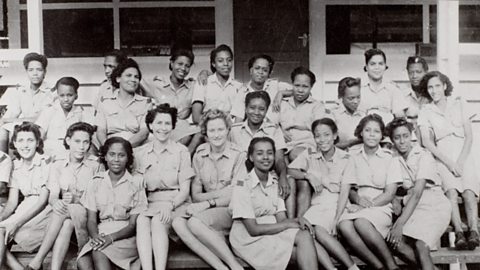
Britain after World War Two
After the war ended, Britain was in ruins. Thousands of homes and buildings had been destroyed by German bombing raids. Many of Britainâs workers had died in the war and the country needed to be rebuilt. Britain particularly needed workers in:
- The transport services
- The postal service
- The new National Health ServiceThe National Health Service (NHS) was created in Britain in 1948 to provide free healthcare to anyone who needed it.
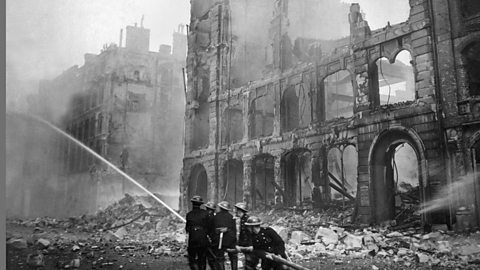
In order to find these workers, Britain reached out to its colonyA country, state or territory ruled over by another country, state or territory. across the world, including in the Caribbean.
The British Nationality Act 1948 meant that people who had a CommonwealthThe Commonwealth was set up in 1926 between Britain and all partly independent countries in the empire, which were also known as dominion states. Eventually other territories within the empire became part of the Commonwealth. passport could live and work in Britain. It also meant that Commonwealth citizens could travel with their Commonwealth passport without needing any extra documents to prove their right to live or work in Britain. Children could also travel on their parentsâ passport, so did not need their own documents.
In school, Caribbean children were taught that they were British citizens and that Britain was their motherland or mother country. This meant that people believed that they would be welcomed, that Britain would look after them and that their lives would be significantly better.
There were also other reasons that people were willing to take the opportunity to help rebuild Britain:
- To escape poverty
- Wages were four to five times higher in Britain
- Many thought it would be a temporary move to help restart their businesses at home
- Others believed they could travel by themselves and then bring their families to join them when they made more money
The Windrush generation
Narrator: In 1948, Britain was just starting to recover from the Second World War. Towns and cities had been bombed, thousands of homes and buildings were destroyed and they all needed to be rebuilt.
In the Caribbean, thousands of men and women had served in the British Armed Forces. After the war, some of them answered an advert to come to Britain, where there were lots of different jobs available. Other people just wanted to see England, which they had heard so much about.
They all got on a ship: the Empire Windrush, which left the Caribbean to travel thousands of miles across the Atlantic Ocean. This was the first time so many Caribbean people had come to live in Britain. Many more arrived in the following years.
It was on 22 June 1948 that the Empire Windrush arrived at Tilbury Docks in Essex. But when its passengers got off, they found that Britain was not as friendly to them as they had hoped. It was cold and grey and the Caribbean people soon experienced racism and discrimination. They found it hard to get proper homes to live in and to make friends with British people.
Later, many of their children were bullied at school because of the colour of their skin. There were racial attacks and years later race riots broke out in cities across Britain. Settling into a new country was difficult, and Black people had to stick together and support one another.
In May 1948, a Jamaican newspaper advertised that a ship would be leaving for Tilbury, England, in a few weeksâ time. People were told that there would be many well-paid job opportunities and accommodation.
On 22 June 1948, the ship, which was called Empire Windrush, landed at Tilbury, Essex, from Jamaica. Estimates vary, but it is estimated that at least 500 of the Empire Windrushâs 1,027 passengers were from Jamaica.
This group of people would be the beginning of what is now known as the Windrush generation.
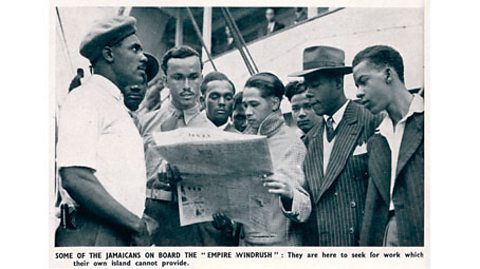
After the first arrival of passengers, the British government continued to recruit workers, including from the Caribbean, to help rebuild Britain. A national population census showed that by 1961 there were just over 161,000 people living in England and Wales who had been born in the Caribbean. By 1971, about 500,000 people had migrated to Britain from the Commonwealth, most of whom came from the Caribbean.
Was everyone in the Windrush generation from the Caribbean?
When talking about the Windrush generation, historians are referring to people who migrated from the Caribbean to Britain from 1948 to 1971.
Experiences of the Windrush generation
When people from the Caribbean arrived in Britain, their experience was far from what they expected. Despite being invited to Britain, many people faced racist discrimination. Many Black people also faced racist violence and harassment.
Despite labour shortages, many Black people were refused jobs because of the colour of their skin and often had to take jobs for which they were overqualifiedWhen someone has more qualifications than they need for a particular job..
It was also difficult to find housing, as many white landlordSomeone who owns a house and rents it out for other people to live in. refused to rent rooms to Black people. The accommodation that was available was often in poorer areas.
What were the Notting Hill riots?
Racist violence in the 1950s was largely driven by gangs of white youths, known as âTeddy Boysâ, who particularly targeted Black men who were in relationships with white women.
In August 1958, a group of people attacked a married couple consisting of a Black man and a white woman. In the days that followed, groups of white people attacked the homes of Caribbean British citizens and many arrests were made.
In 1959, Kelso Cochrane, a Caribbean carpenter, was murdered in the Notting Hill area. This was the first clear example of a racially motivated killing in London.
Case study: Sam King
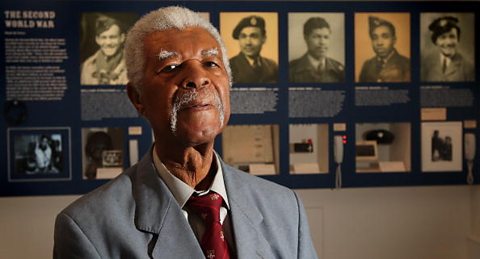
Sam King was born in Jamaica in 1926. After serving as an engineer in the RAFThe Royal Air Force - the collective name for Britain's fighter and bomber planes. during World War Two, he returned to Jamaica but was one of the hundreds who travelled aboard the Empire Windrush in 1948. On returning to Britain he again served in the RAF.
He then applied to work for the Metropolitan PoliceThe police service responsible for enforcing the law and preventing crime in Greater London., but his application was rejected. After this, King worked for the postal service for over 20 years. He then became the Mayor of the London Borough of Southwark from 1983 - 1984.
In 1995, Sam King set up the Windrush Foundation to remember the lives and experiences of the first wave of people who migrated to Britain from the Caribbean after World War Two.

The impact of Empire Windrush
Increased levels of migration to Britain, including the Windrush generation, resulted in changes to immigrationComing to live permanently in a foreign country. law. The laws introduced from 1962 were a direct attempt to reduce the levels of immigration into the country.
The Commonwealth Immigrants Act 1968 and the Immigration Act 1971 were focused more on migration from Asian communities in East Africa. They reduced the number of people who could migrate to Britain and limited the time they could live and work in Britain.
| British Nationality Act 1948 | Anyone with a Commonwealth passport had the same legal right to live and work in Britain as anyone with a British passport. |
| Commonwealth Immigrants Act 1962 | People with a Commonwealth passport no longer had the automatic right to live and work in Britain, and instead had to apply for work permits. These work permits were mostly given to white citizens in Dominion states. |
| Commonwealth Immigrants Act 1968 | Under this act people from Commonwealth countries who did not have a parent or grandparent born in Britain were subject to the same immigration controls as people from non-Commonwealth countries. |
| Immigration Act 1971 | Work permits were replaced with employment vouchers that were only given for a set period of time. This meant that most migration that was allowed would be temporary. |
Most historians consider Windrush migrantA person moving between countries or continents, often to seek work or better living conditions. to have arrived in Britain between 1948 and 1971. While people from the Caribbean did migrate to Britain after 1971, they faced stricter immigration rules due to the Immigration Act 1971 and are not considered to be part of the Windrush generation.
What did the Immigration Act 1971 mean for the Windrush generation?
The Immigration Act 1971 granted permanent leave to remainThe legal right to stay and live in a country. in Britain to those who migrated before 1971. This meant that those who were part of the Windrush generation remained legal migrants and could stay in Britain to live and work. However, no paperwork stating that they had the right to permanently remain in Britain was given to these individuals.
The Windrush scandal
In 2017, the Windrush scandal revealed that many people who were part of the Windrush generation had been wrongly held and deportationRemoving a person or group of people from a place or country. back to the Caribbean.
Many of the Windrush generation had arrived in Britain as young children on their parentsâ passports, without papers of their own. The only proof of their status as legal migrants in Britain were landing cards, which had been collected from them upon their arrival in Britain.
These landing cards were destroyed by the Âé¶čÔŒĆÄ OfficeOne of the departments of the UK government. It deals with immigration, security and law and order. in 2010, which meant by 2017 some people had no proof of their legal status. However, the government still said they required a legal document for every year of their time in Britain, which was impossible for many. This led to many people being wrongly deported.
The government apologised for the scandal, and set up a commissionA group of people given the task of investigating or solving something by the government. for compensation When money is given to someone to make up for loss or suffering. to be given to people who were impacted. By April 2019, 15,000 people were eligible for compensation. By November 2021 only 5.8 per cent of the 15,000 had received compensation and 23 of those impacted had died receiving no compensation. As of 2021, some people who were impacted by the scandal were still waiting to receive compensation.
The cultural impact of the Windrush generation
British culture has been shaped and transformed by the hundreds of thousands of people who brought their culture to Britain. Caribbean influence can be found today across Britain, from food to music, sport to literature.
One individual from the Caribbean who made a significant cultural impact on British culture was Claudia Jones. She was born in Trinidad and TobagoA country in the Caribbean, formed of two islands. It was a British colony from 1802 to 1962., and migrated to Britain as part of the Windrush generation. Jones became a civil rights activistA person who is part of a political movement that works towards achieving equal opportunities for minority groups. and a journalist, raising awareness of the poor treatment of immigrants in Britain.
In 1959, she organised an event to celebrate Caribbean culture. This event would become the Notting Hill Carnival in 1966. It is now one of the biggest street festivals in the world. It attracts over nearly 2 million people each year, celebrating Caribbean food and music.
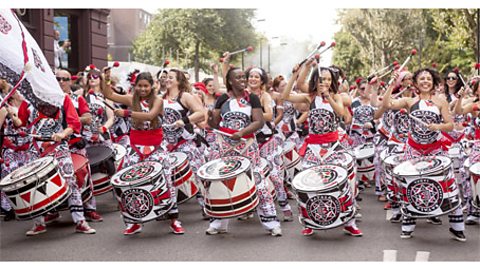
How is the Windrush generation celebrated?
Windrush Day is celebrated in Britain on 22 June every year, to mark the day that Empire Windrush docked in Tilbury, Essex. As well as cultural events, the holiday is celebrated with church services and exhibitions.
A model of the Empire Windrush was included in the 2012 London Olympics opening ceremony.

Test your knowledge
Play the History Detectives game! gamePlay the History Detectives game!
Analyse and evaluate evidence to uncover some of historyâs burning questions in this game.

More on Post-war migration from Africa, the Caribbean and Asia
Find out more by working through a topic
- count2 of 2
